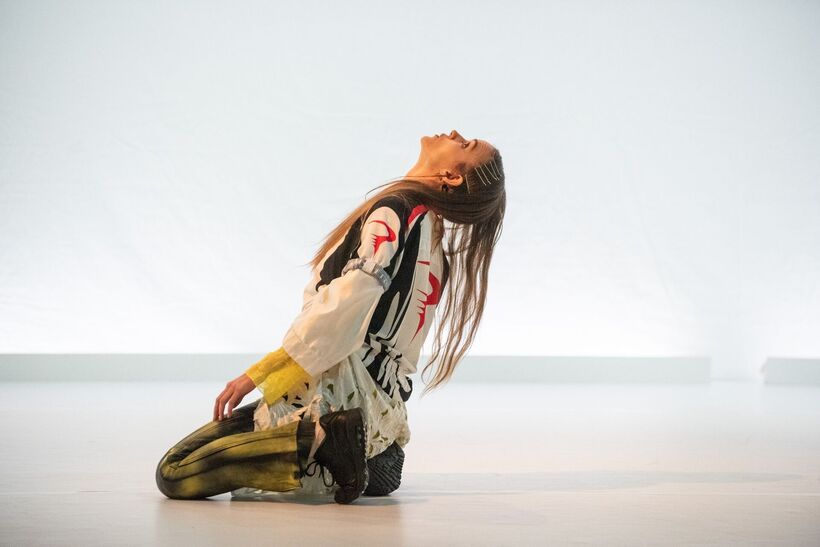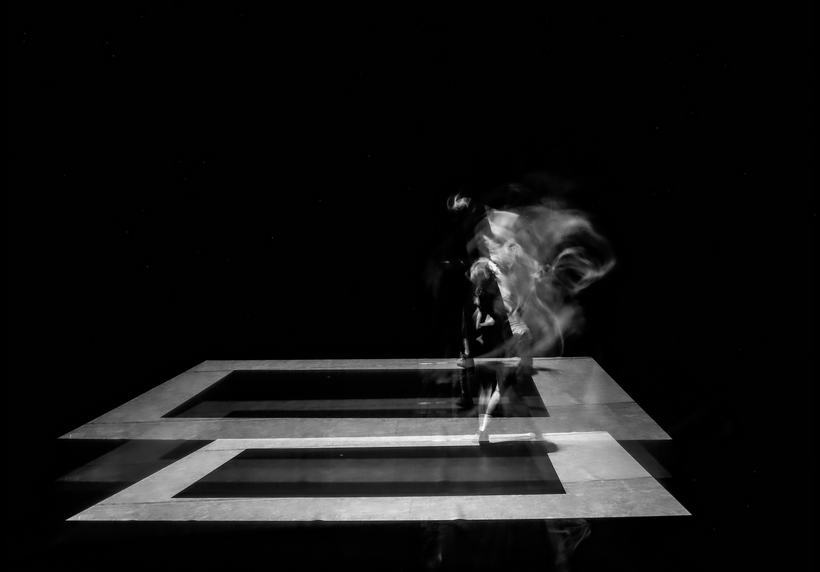Cold Hawaii and DEMONstratio at STUK – The Politics of Abstract Spaces
What does it mean to be radical today? At the vanguard of the Belgian contemporary dance scene, STUK might be as good a place as any to check the temperature. Two pieces from the start of the 23/24 season are eminent explorations of what the political semiotics of dance can be.
Just 30 km from Brussels, in the heart of the old university city of Leuven, stands STUK, a House of Dance, Image and Sound. Emerging from student movements of the 1970s, it has become a crucial proving ground for new generations of dancers. Anne Teresa De Keersmaeker, Jan Fabre, Marc Vanrunxt, and Alain Platel are just some of the prominent names that proved their mettle at STUK.
Judging by the performances from Sigrid Stigsdatter Mathiassen and Milø Slayers that opened the autumn programme, we can conclude that the theatre hasn’t forgotten its old affinity with avant-garde experimentation. They are brilliant examples of the subversive political potential inherent in dance, even in its most abstract and conceptual forms, delivering penetrating critiques of racism and of the suppression of desire. The performances were particularly remarkable for their shared preoccupation with the representation of space and borders, and in their innovative and powerful use of the human voice and language as a choreographic and semantic tool.
***
The dance season opened with Danish artist Sigrid Stigsdatter Mathiassen’s dance piece Cold Hawaii. As we assemble in the auditorium, we see a stage dominated by a white semicircle formed by bleached, empty walls, a border ‘between harsh realities and soft worlds of imagination’. The geometric minimalism of the set embodies the coldness implied by the title. It is an oxymoron: Hawaii – a ‘utopian’ image – turned upside down. These constant dichotomies, the internal and external tensions and struggles follow us throughout the performance. Mathiassen begins in a kind of isolation of her own, sitting with her back to the white walls, small and alone in the big white space. It is as if she is hypnotised, moving to undulating, insistent electronic music by Lora Deniz. The movements pass through her in waves. At times, she appears distracted and naïve, at other times self-conscious and sensual. This isolated white space is her own imaginary land. Protected, but from what? Her gaze shifts towards us, piercing us. Communication is only established to reveal that the content of the message is anything but pleasant.
She leaves her fantasy safe zone and emerges at the centre of the stage, finally exposed to the brutality of existence. She addresses the audience directly with a foul-mouthed monologue, rambling about her lost dreams. She stares at us while slowly putting her fingers in her mouth one by one. Deep red blood-mucus gushes down her face, her throat, her body. Bitter frustration translates to irritable, then increasingly erotic movements: “Oh my God. Yes, yes, yes. Oh, yes, yes, yes. Harder, baby, harder.” Mathiassen emphasises the pleasure of the abject, the dark side of desire. The erotic impulses culminate in a wild dance, where she humps frenetically, trembling from head to toe. She is a dancing demon that is not afraid to return our gaze, to challenge us. The change of colours on stage symbolises this trespassing, a shift from white to green and red. Abruptly, she goes back to white: “Sometimes all I need is a little privacy, a moment when my body is just mine”. The performance is suddenly finished. We are not served any cathartic release, only the nightmarish, haunting memories remain.
***
In DEMONstratio by Brussels-based choreographer Milø Slayers, the dramaturgy of space is evident again. In contrast with Mathiassen’s sterile whiteness, Slayers creates a pure form of darkness, a square black hole. The immediate inspiration for the piece came to Slayers from the story of Kasimir Malevich’s famous suprematist painting Black Square (1913). In 2015, a hidden racist inscription was revealed on the painting’s canvas by X-ray: ‘Negroes struggling in a cave’. This triggered Slayers to think about the illusion of ‘political neutrality’ in even the most abstract of art forms. The black, empty square on stage is never decoded but remains an oppressive centre around which the three performers revolve. This square, framed with LED lights, is a heavy socio-political signifier…
The first dancer (Milka Kongi) enters while the lights in the theatre are still on. As she steps into the black space, darkness engulfs us all. Here, one must conform to survive. Her body is naked, her movements are ‘freaky’: One eye closed, the other bulging painfully, while her lips are sneering inhumanly to one side. She holds her breath, inflating like a balloon about to pop. She breathes out, then pants loudly, rhythmically. Her body is resisting the painful grimaces, contortions, and the cruel force it is subjected to. One by one, the other dancers enter the square. In extreme contortions and grimaces, their bodies obey the role of sub-humans ascribed to them by that invisible, racist inscription. Their loud, painful panting creates a constant rhythm of resilience.
After their perverse initial ‘solos’, the three dancers re-enter the square together. Now, they appear in front of us as three crooked shadows in long black coats, like Macbeth’s three witches. The square now becomes an X-ray zone and a fractal reality, where the squares multiply themselves in a twisting and changing grid created by an overhead projector. The border between the visual simulacra and the realness of the bodies is erased, lost in a matrix.
Also in this performance, the spoken word gradually takes centre stage. First, the loud panting is joined by primal screams and shouting. Then, hesitantly, stammers and stutters, words and fragments of sentences emerge. Their heads jerking and their lungs gasping for air, the three witches laboriously bring to life a grotesque, polyphonic language. From mute body language to words and phrases, linguistic evolution happens before our eyes. But the words that emerge from this primordial scene bring darkness with them. From the fragments we decipher a distressing message: “ouvrons les oeuvres” (let’s open the works), “tout à fait monstre” (quite a monster), “nous” (we), “nègre” (negro).
***
While neither space nor voice are in any way new preoccupations in dance, the centrality of these themes in both pieces is a powerful testimony to their political relevance. Politics is about the division of space and the concession and repression of a voice. Both Mathiassen and Slayers reserve the centre of the stage for the agora in a playful and innovative way. STUK’s autumn programme eminently demonstrates how dance – as the embodiment of expression in space par excellence – cannot avoid being political. And when it works, the most abstract of dance pieces can deliver a thundering message.
Written from STUK, Leuven, Belgium, September-October 2023.
Cold Hawaii
Concept, Choreography and Performance: Sigrid Stigsdatter Mathiassen
Music: Lora Deniz
Costume: Ginta Tinte
Dramaturgy: Antonia Steffens
Artistic advice: Merel Heering and Kristin De Groot
Technology and lighting design: Edwin van Steenbergen
Video and trailer: Paul Sixta
Photography: Anna van Kooij
DEMONStratio
Concept: Milø Slayers
Performers: Sophie Sénécaut, Eli Mathieu, Milka Kongi
Light: Luc Schaltin
Projection: Ulysse Navarro, Geminay
Costume: Céline Shen
Dramaturgy: Yasen Vasilev
Urban dramaturgy: Marie Umuhoza
Theoretical dramaturgy: Tunde Adefioye
Sound design: Milø Slayers






